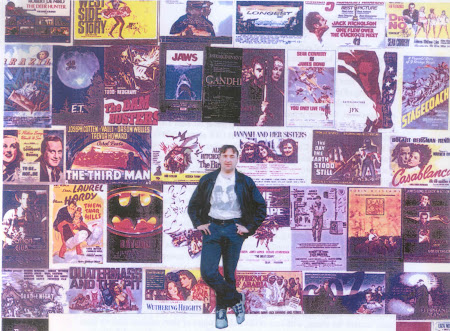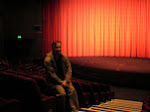 A few years ago when a group of us were putting together ideas for an experimental film, we discussed ways to convey unusual visual metaphors in the camera, and a couple of us mentioned how we'd recently seen Once Upon a Time in the West on TV, and remembered in particular a recurring scene of a blurred figure on the horizon, constantly walking in the distance towards the camera. It is one of many indelible images that Sergio Leone would use in his films, and Once Upon a Time in the West is one of his finest, quirkiest, most haunting of epics.
A few years ago when a group of us were putting together ideas for an experimental film, we discussed ways to convey unusual visual metaphors in the camera, and a couple of us mentioned how we'd recently seen Once Upon a Time in the West on TV, and remembered in particular a recurring scene of a blurred figure on the horizon, constantly walking in the distance towards the camera. It is one of many indelible images that Sergio Leone would use in his films, and Once Upon a Time in the West is one of his finest, quirkiest, most haunting of epics.Leone had of course, become famous for his "Spaghetti" Westerns, a new resurgence in the genre with Clint Eastwood immortally linked to the series, but otherwise mostly Italian actors pretending to be American (and seemingly deliberately badly dubbed), and filmed in the Spanish desert pretending to be the Wild West. They made a killing at the box office, in more ways than one. For some it was a cynical, violent reproach to the good old days of the Hollywood Western, but whether or not you liked the method of film making, they had an undeniably rich stylization about them, coupled with Ennio Morricone's lyrical music.
Both Leone and Morricone pulled out all the stops for this one.
Once Upon a Time in the West was also
 an opportunity for Leone to actually explore these American locations for real - production difficulties only allowed him to film in certain iconic locations such as Monument Valley (used for many a John Ford epic), but in a very unusual, distinctively Leonesque style.
an opportunity for Leone to actually explore these American locations for real - production difficulties only allowed him to film in certain iconic locations such as Monument Valley (used for many a John Ford epic), but in a very unusual, distinctively Leonesque style.Just take the beginning, where for a whole TEN minutes we have the credits lazily dragging themselves in, whilst three gunmen (Jack Elam, Woody Strode and Al Mulock) sit around at the railroad station......waiting - for someone (Charles Bronson) who isn't going to get a pleasant reception. Legend has it that Leone wanted his three original stars of The Good, the Bad and the Ugly - Clint Eastwood, Lee Van Cleef, Eli Wallach - to play the three assassins, who are thereby killed off within the first reel.
Soon after that, the body count doesn't get any lower, as an Irish family are unexpectedly and ruthlessly wiped out by an anonymous gang of killers, headed by: Henry Fonda, of all people - another of Leone's quirky and darkly cynical touches, turning the Western convention on its head by having Fonda, so often the image of upstanding, dependable American values, to be the ruthless psychopathic killer. It's casting which sits uncomfortably with his other roles, although in a sense it has a perfect logic: Fonda was so often the defender of men, women and children, so naturally he also becomes their exterminator, like the fallen angel: as one critic of the time put it, who else could do such a dreadful deed but Henry Fonda?
the Western convention on its head by having Fonda, so often the image of upstanding, dependable American values, to be the ruthless psychopathic killer. It's casting which sits uncomfortably with his other roles, although in a sense it has a perfect logic: Fonda was so often the defender of men, women and children, so naturally he also becomes their exterminator, like the fallen angel: as one critic of the time put it, who else could do such a dreadful deed but Henry Fonda?
 A moment of lost maternal comfort for Jill McBain.
A moment of lost maternal comfort for Jill McBain.
It's hard to tell who exactly is the leading character in OUATITW: maybe each of the four main characters (five if we include Gabriele Ferzetti's railway tycoon) cover the various aspects of the West: the frontiersman's wife/widow Jill McBain (in the very Italian shape of Claudia Cardinale), or Fonda's evil gunman Frank, or Jason Robards in fine Doc Holliday-like form as Cheyenne, or Bronson's "man with no name", usually considered the lead role but here bizarrely given fourth billing.
 Watching it nowadays, it seems quite acceptable to see Charles (Death Wish) Bronson in a film where loads of people are getting killed, but back in 1969 it was an unexpectedly startling moment - and the flashback scene where the mysterious man on the horizon is finally revealed - is one of the most memorable payoffs in cinema history.
Watching it nowadays, it seems quite acceptable to see Charles (Death Wish) Bronson in a film where loads of people are getting killed, but back in 1969 it was an unexpectedly startling moment - and the flashback scene where the mysterious man on the horizon is finally revealed - is one of the most memorable payoffs in cinema history.

The melancholy of the film is reflected by Ennio Morricone's beautiful score, with not just one but three main themes - the stirring and startling "Harmonica" theme which covers Henry Fonda's character quite well too, the rickety banjo of Cheyenne's theme, and the beautiful main theme to the McBain family and the railroad; a very operatic Italian perspective on the classic American Wild West. Long, violent, elegiac, and utterly absorbing.


